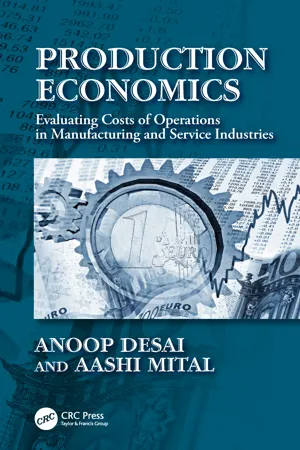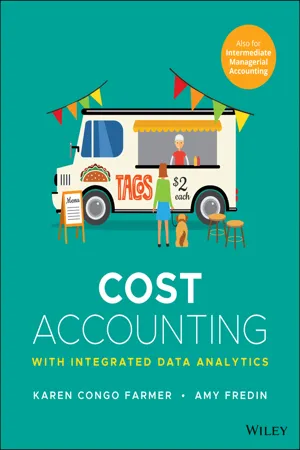Business
Break-Even Analysis
Break-even analysis is a financial tool used to determine the point at which a company's total revenues equal its total costs, resulting in neither profit nor loss. It helps businesses understand the level of sales needed to cover all expenses and is crucial for decision-making, pricing strategies, and setting sales targets.
Written by Perlego with AI-assistance
Related key terms
1 of 5
11 Key excerpts on "Break-Even Analysis"
- eBook - ePub
Production Economics
Evaluating Costs of Operations in Manufacturing and Service Industries
- Anoop Desai, Aashi Mital(Authors)
- 2018(Publication Date)
- CRC Press(Publisher)
12 Break Even and Benefit Cost Analysis 12.1What Is Break Even Analysis?Break even analysis is a very important tool that is commonly used in economic decision making. The essence of break even analysis is that in every business scenario, there will be a situation wherein the total cost incurred in producing a product or offering a service will invariably be offset by the total revenue obtained from selling it. This scenario is referred to as break even. “Breaking even” occurs when the total cost is equal to total revenue implying that neither any profit nor loss is incurred. It can also be used to compare process costing between different alternative processes. Break even analysis is used for a variety of economic evaluations such as:• To compare different processes of manufacturing in order to determine the most economical option at various production levels.• Once the production run (level) has been determined, it is necessary to establish the minimum selling price of the product. Break even analysis is helpful in this evaluation. If revenue is equal to total production cost, then the minimum selling price of the product will have to be equal to total production cost (which is equal to revenue at break even production levels) divided by the number of units produced (production run).• To determine the actual number of units that has to be produced so that total revenue will be equal to total cost. This production run is referred to as break even point.It will be obvious from the preceding discussion that in order to use break even analysis, it is essential to be able to correctly evaluate total cost of production. We have already dealt with this concept in previous chapters. In Chapter 2 , we dealt with cost estimation, in Chapter 3 , we dealt with material costing, Chapter 4 considered process costing and overhead costs and capital expenses were dealt with in Chapters 5 and 6 - eBook - ePub
- Richard Kotas(Author)
- 2014(Publication Date)
- Taylor & Francis(Publisher)
5Break-Even Analysis
Introduction
A simple break-even chart has already been illustrated. The purpose of the present chapter is to describe different kinds of break-even charts and show their applications to a variety of different situations.The term ‘break-even chart’ is rather unfortunate in that it focuses attention on one particular aspect of what is, in fact, a complex set of sales—cost—profit relationships. The principal aim of the break-even chart is not merely to ascertain the actual or potential break-even point, but also to show what net profit or loss will obtain over the whole range of activity, at what rate net profit will accrue when sales increase above the break-even point, the degree of profit stability of the business, etc.One of the main objectives of the break-even charts is to show, preferably in simple terms and without excessive detail, the total sales—cost—profit picture of the business. If it is to achieve this objective, it must be presented as an elegant, well thought-out document and create the right kind of visual impression. It is, consequently, better for the break-even chart to show only the essential data; other information may be given in appropriate schedules, profitability statements and similar documents.Basic break-even chart
The basic break-even chart is the starting point for a more detailed consideration of Break-Even Analysis. Let us therefore take a simple example, construct a basic break-even chart and then look at some of its main features.Figure 5.1 Basic break-even chartIt is assumed that a business has up to 10,000 customers per month and that its ASP is £10.00. Monthly fixed costs are £40,000 and variable costs are incurred at the rate of 40 per cent in relation to the volume of sales. The break-even chart for this operation would appear as shown in Figure 5.1 . The information disclosed by the break-even chart is as follows.Break-even pointThis is reached when the number of covers is over 6,500. As explained in the previous chapter, the expected break-even point (in terms of the number of covers) may be calculated by dividing fixed costs by the contribution per cover, which in the present example is £6.00. Hence: - eBook - ePub
- Michael W. Fountain, Thomas W. Zimmerer(Authors)
- 2018(Publication Date)
- SAGE Publications, Inc(Publisher)
Breakeven analysis is conducted based on the new firm’s start-up cost and the projected monthly expenses and projected revenues. These initial expenses are very often underestimated. Legal fees, building or office leases, equipment, inventories, supplies, licenses, tools, utilities, and initial staffing costs comprise a significant initial investment. In addition, the entrepreneur must normally maintain a capital reserve large enough to carry the business until revenues are sufficient to reach the point of breaking even. An effective financial analysis must identify, based on revenue and cost projections, how long it will take to reach breakeven, as well as how much money will be needed until that point is reached. This financial analysis is essential in assuring that the new venture has the capital that will be required to survive. The breakeven point is the level of operations at which a business neither makes a profit nor incurs a loss. When sales revenues equal expenses, the firm breaks even. By conducting a thorough and in-depth analysis of cost and expenses, the entrepreneur can estimate the minimum level of business activity required to keep the firm operating. These techniques can then be refined to project the sales revenues needed to generate the desired profit.Constructing a breakeven analysis begins with determining which anticipated costs are fixed and which are variable in nature. Fixed expenses are those that do not vary with changes in the volume of sales or production. Examples would be rent and interest payments. Variable expenses vary directly with changes in the volume of production or sales. Examples would be sales commissions and raw materials cost. To proceed, the entrepreneur uses the projected budget to estimate both the sales revenues and costs, which, as mentioned, are allocated based on whether they are fixed or variable. Next, the ratio of variable expenses to projected net sales is used to determine what percentage of every dollar of sales it takes to cover the variable expenses. What remains is the percentage of sales available to pay for fixed expenses. This portion of the sales revenue is called the contribution margin - John A. White, Kellie S. Grasman, Kenneth E. Case, Kim LaScola Needy, David B. Pratt(Authors)
- 2020(Publication Date)
- Wiley(Publisher)
The term break- even point is sometimes used instead of break-even value; however, within this text, we will use the latter term. Break-Even Analysis A method used when an accurate estimate of a parameter’s value cannot be provided, but intelligent judgments can be made as to whether or not the value is less than or greater than some break-even value. 222 CHAPTER 11 Break-Even, Sensitivity, and Risk Analysis the discounted payback period, when the TVOM is greater than 0. (Also, recall that the Excel® NPER worksheet function can be used to determine how long uniform annual sav- ings must occur in order to fully recover an initial investment, given a desired return on investment.) In an engineering economic analysis, Break-Even Analysis is often used to determine the level of annual savings required to justify a particular capital investment. In a replace- ment study, Break-Even Analysis is often performed on the purchase price or salvage value of the replacement alternatives. Likewise, Break-Even Analysis might be used to deter- mine how long annual savings must occur in order to economically justify a particular investment. Excel® Video Lesson: NPER Financial Function EXAMPLE 11.1 Determining the Break-Even Value for Units Sold The Gizmo Manufacturing Company is considering making and selling a new product. The following data have been provided to management: Sales price $17.50/unit Equipment cost $250,000 Incremental overhead cost $50,000/year Sales and marketing cost $150,000/year Operating and maintenance cost $25/operating hour Production time/1,000 units 100 hours Packaging and shipping cost $0.50/unit Planning horizon 5 years Minimum attractive rate of return 15% Some managers are reluctant to launch a new product because of the uncertainty of future sales.- eBook - PDF
- Charles E. Davis, Elizabeth Davis(Authors)
- 2020(Publication Date)
- Wiley(Publisher)
Unit 3.1 Breakeven Analysis 3-5 Notice that this formula is just a restatement of the mathematical operations made between Steps (3) and (4). Sometimes it is useful to know the breakeven point in terms of sales dollars rather than units. If we know the breakeven point in units, we can simply multiply it by the sales price per unit: $30 × 40,000 = $1,200,000. Alternatively, we could use the contribu- tion margin ratio and the profit relationships examined on the previous page, as in the following formula: Total fixed expenses ______________________ Contribution margin ratio = Breakeven point in sales dollars $240,000 _ 0.20 = $1,200,000 in sales dollars to break even Breakeven Graphs While calculating a breakeven point is useful, managers are also interested in the profits generated at other sales levels. A breakeven graph illustrates this relationship between sales revenue and expenses, allowing managers to view a range of results at a single glance. Exhibit 3.2 shows Universal’s breakeven graph based on the company’s sales and expense information. Notice that the total sales revenue line intersects the y-axis at $0 and has a slope of $30; for every jersey sold, Universal takes in $30 of revenue. The fixed expense line inter- sects the y-axis at $240,000 and remains constant across all sales volumes. Even if no jerseys were sold, the company would incur fixed expenses of $240,000. The total cost line represents the sum of fixed and variable expenses, so it intersects the y-axis at $240,000 and increases at a rate (slope) of $24 per jersey. The point at which the total sales revenue line and the total expense line intersect is the breakeven point. Any level of sales to the left of the breakeven point represents an operating loss. Any level of sales to the right of the breakeven point rep- resents operating income. One of the activities managers like to engage in is called “what-if” analysis, or sensitivity analysis. - eBook - PDF
Accounting
Business Reporting for Decision Making
- Jacqueline Birt, Keryn Chalmers, Suzanne Maloney, Albie Brooks, David Bond, Judy Oliver(Authors)
- 2022(Publication Date)
- Wiley(Publisher)
Kylie now knows that costs will increase at the rate of $10 per online order due to the variable cost behaviour and that fixed costs will remain constant at $100 000. For example, if she wanted to know the total cost at 5100 online orders, we would determine the variable cost (5100 × $10) and then add the fixed cost ($100 000), which would give a total cost of $151 000. An understanding of fixed and variable costs is necessary in order to explore Break-Even Analysis. 10.2 Break-Even Analysis LEARNING OBJECTIVE 10.2 Prepare a Break-Even Analysis for single-product and multi-product entities. Break-Even Analysis relates to calculation of the necessary level of activity required in order to break even in a given period. Break-even occurs when total revenue and total costs are equal, resulting in zero profit. There are a number of ways in which the break-even calculation can be made. (Illustrative example 10.1 explores the more popular of these.) Break-Even Analysis draws on the traditional understanding of fixed and variable costs to introduce the concept of the contribution margin. The contribution margin is calculated by deducting the total variable costs from the total revenue. To determine the contribution margin per unit the variable cost per unit is deducted from the revenue per unit. We can think of the contribution margin as that amount of revenue that contributes in the first instance towards fixed costs with any excess contributing to profit. Alternatively, if the contribution margin does not cover fixed costs, then the entity is in a loss-making situation. At break- even point, the total contribution margin is equal to the fixed costs. We now calculate break-even for single-product and multi-product entities, and highlight the differences in calculation for each. Break-Even Analysis is an important tool for entities such as airlines to understand the financial impact of changing cost structures. Pdf_Folio:389 CHAPTER 10 Cost–volume–proft analysis 389 - eBook - PDF
Cost Accounting
With Integrated Data Analytics
- Karen Congo Farmer, Amy Fredin(Authors)
- 2022(Publication Date)
- Wiley(Publisher)
However, we must know which business ideas to pursue and which to scrap when their feasibility doesn’t make dollars and sense. 4.1 Contribution Margin and the Break-Even Sales Point LEARNING OBJECTIVE ❶ Calculate the contribution margin and break-even sales point. Data Analytics in Action Consuming Coffee and Trends At Starbucks, the role of a senior business analyst for store devel- opment and design mines relevant information from databases— presumably on locations, traffic patterns, demographics of the area, and consumer behavior—to support site decisions for new stores. This employee also develops data models and data visualizations. What is a data visualization? Data interpreted in an appeal- ing way to convey meaning. One example is a traffic map with one street colored dark red illustrating the highest traffic levels, while parallel streets might be in yellow to indicate less traffic. Source: Starbucks website. Data analytics activities, including Excel-based problems with data sets, are available at the end of the chapter. The ability to do a snap calculation as a simple measure of an enterprise’s feasibility is an important business (and life) skill. The general purpose of this calculation—for your business venture—is to determine: • Given my current cost structure, how much would I need to sell to break even? • How much more would I need to sell to earn my target profit? • How much more would I need to sell to make enough to save and eventually retire? For example, in the back of your mind, you wonder about turning your current hobby into a busi- ness venture. Paisley, your pooch, is paws-itively giddy for your homemade dog biscuits, and you’ve made a range of flavors to tempt her. To date, her favorite is Banana Breath, with Lemon Licks a close second. Your dog’s friends seem equally impressed. Could this be worth pursuing further? Your first step is to calculate the break-even point of your venture. - eBook - ePub
- Robert Wilson(Author)
- 2011(Publication Date)
- Routledge(Publisher)
Total revenue = Total costs. Let us have a look at an example so that you can see how this works in practice:£ Revenue 100 LessVariable costs 60 EqualsContribution 40 LessFixed costs 40 EqualsProfit (or loss) 0 If you have followed this you will see that it also stands that at breakeven contribution = fixed costs.VC(+ FC6 0)(= TC4 0)(, TR = 1 001 00)Therefore we have B/E .Once you have grasped this concept you can calculate breakeven points relatively easily from marginal costing data. Depending on your responsibilities, it is worth mentioning here that the B/E point may be expressed as:- the number of items needed to be sold to breakeven, or
- the total sales required to breakeven.
Key term Breakeven point The level of activity at which there is neither a profit nor a loss. It may be measured in terms of units of production or sales revenue.Establishing the breakeven point in units
Remember that breakeven occurs when contribution is just enough to cover fixed costs, with nothing left over for profit. So, providing that we know what fixed costs are, the contribution needed for breakeven is known.ActivityFirst, what is the contribution per unit?Imagine that Kitlocker.com sell pairs of running shoes for £25. The marginal cost per unit (i.e. per pair of shoes) is £15. Remember that marginal cost is another term for variable cost.
Now assume that the fixed costs are £3,600 for one month's trading. What is the breakeven point in units needed to be sold?£ Unit price 25 LessUnit variable cost 15 EqualsUnit contribution 10
If you answered 360 units then you are correct. The following steps were probably used to calculate this figure:Quantity Unit price Revenue % Relationship Revenue 360 25 9,000 100 LessVariable cost 15 5,400 60 EqualsContribution 10 3,600 40 LessFixed cost 3,600 EqualsProfit 0 - eBook - ePub
- D. Crowther(Author)
- 2007(Publication Date)
- Routledge(Publisher)
Figure 6.1 .Figure 6.1 Break Even ChartFrom this chart it can be seen that up to the level of output b the firm is operating at a loss and for levels of output in excess of b the firm is operating at a profit. This point is known as the break even point – that is the point at which neither a loss nor a profit is being made.Point c represents the planned level of activity and at this point the expected profit level is represented by e d. The difference between the planned level of activity and the break even level of activity (i.e. c b) is known as the margin of safety and represents the amount by which actual output may fall short of that planned without a loss being incurred. The margin of safety is expressed as a percentage of sales, and can be expressed either in terms of number of units or in terms of revenue. - eBook - PDF
- Robert Parrino, David S. Kidwell, Thomas Bates, Stuart L. Gillan(Authors)
- 2021(Publication Date)
- Wiley(Publisher)
The EBITDA and EBIT crossover levels of unit sales are calculated using Equations 12.5 and 12.7, respectively. 4 Define the economic break-even point and be able to calculate it for a project. The economic break-even point is the number of units that must be sold each year during the life of a project so that the NPV of the pro- ject equals $0. Section 12.4 illustrates how the economic break-even point is calculated. 5 Define sensitivity analysis, scenario analysis, and simulation analysis and describe how they are used to evaluate the risks associated with a project. Sensitivity analysis is concerned with how sensitive the output from a financial analysis, such as the NPV, is to changes in an individual assumption. It helps identify which assumptions have the greatest impact on the output and, therefore, on the value of a project. Know- ing this helps an analyst identify which assumptions are especially important to that analysis. Scenario analysis is used to examine how the output from a financial analysis changes under alternative sce- narios. This type of analysis recognizes that changing economic and market conditions affect more than one variable at a time and tries to account for how each of the different variables will change under alternative scenarios. Simulation analysis is like scenario analysis except that in simulation analysis a computer is used to examine a large number of scenarios in a short period of time. - No longer available |Learn more
- Don Hansen, Maryanne Mowen(Authors)
- 2017(Publication Date)
- Cengage Learning EMEA(Publisher)
2 Other airlines faced different market conditions and a less favorable outcome. Air India and Jet Airways were hurt by the weak rupee (Indian currency). The unfavorable currency exchange rate meant that fuel costs (denominated in dollars) would have to be offset by revenues that are denominated in rupees. The fall of the value of the rupee increased costs such that SpiceJet and Jet Airways faced failure to break even. 3 CVP analysis can address many issues, such as the number of units that must be sold to break even, the impact a given reduction in fi xed costs can have on the break-even point, and the impact an increase in price can have on pro fi t. Additionally, CVP analy-sis allows managers to conduct sensitivity analyses by examining the impact of various price or cost levels on pro fi t. While this chapter deals with the mechanics and terminology of CVP analysis, your objective in studying CVP analysis is more than to learn the mechanics. CVP analysis is an integral part of fi nancial planning and decision making. Every accountant and man-ager should thoroughly understand and be able to apply its concepts. THE BREAK-EVEN POINT AND TARGET PROFIT IN UNITS AND SALES REVENUE To fi nd out how revenues, expenses, and pro fi ts behave as volume changes, it is natural to begin by fi nding the fi rm ’ s break-even point in units sold and in sales revenue. Two frequently used approaches to fi nding the break-even point are the operating income approach and the contribution margin approach. We will discuss these two approaches to fi nd the break-even point (the point of zero pro fi t) and then see how each can deter-mine the total sales revenue at break-even. The determination of units or revenue needed to achieve a target pro fi t is a generalized case of the break-even formulas. The fi rst step in implementing a units-sold approach to CVP analysis is to determine just what a unit is.
Index pages curate the most relevant extracts from our library of academic textbooks. They’ve been created using an in-house natural language model (NLM), each adding context and meaning to key research topics.










